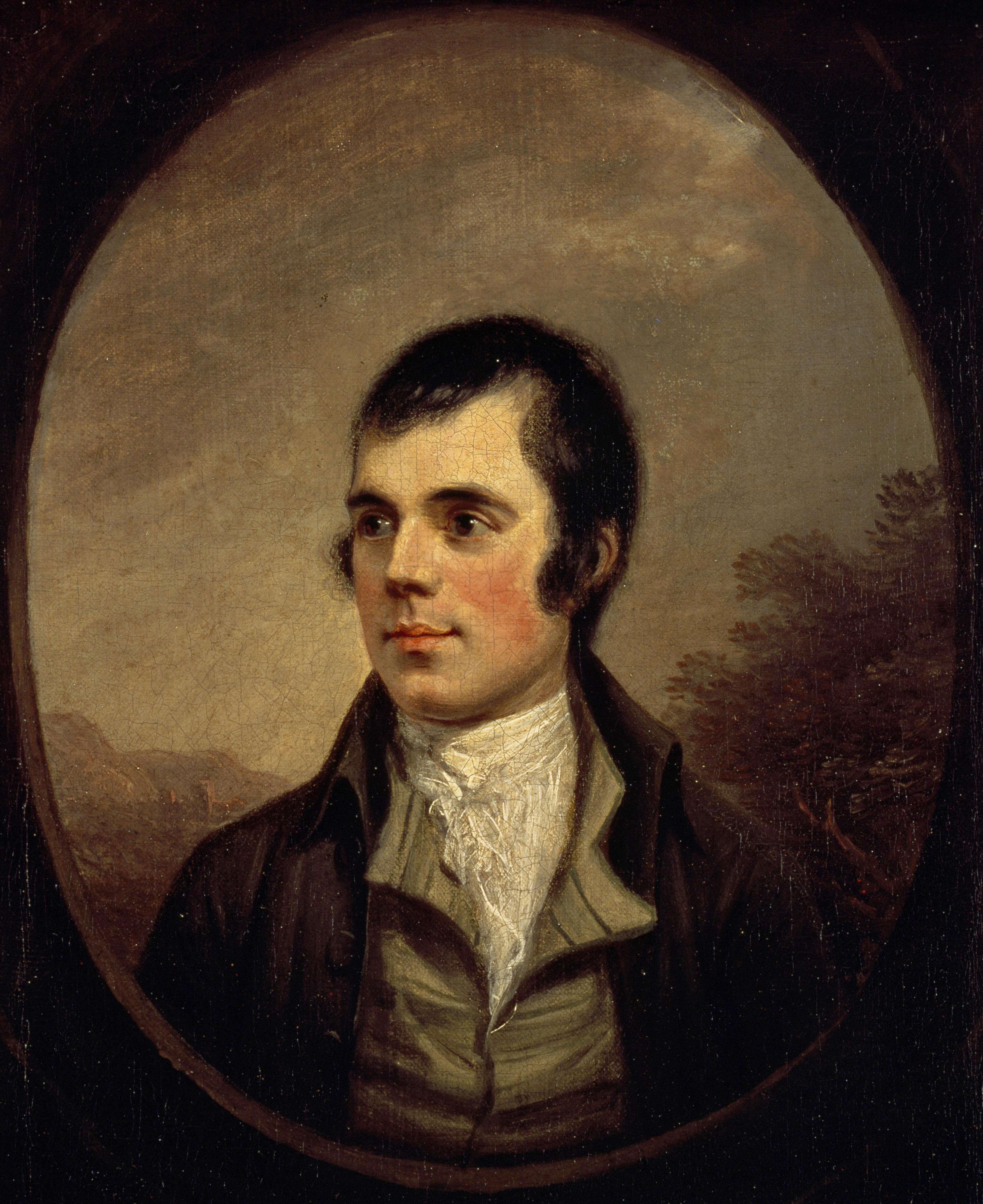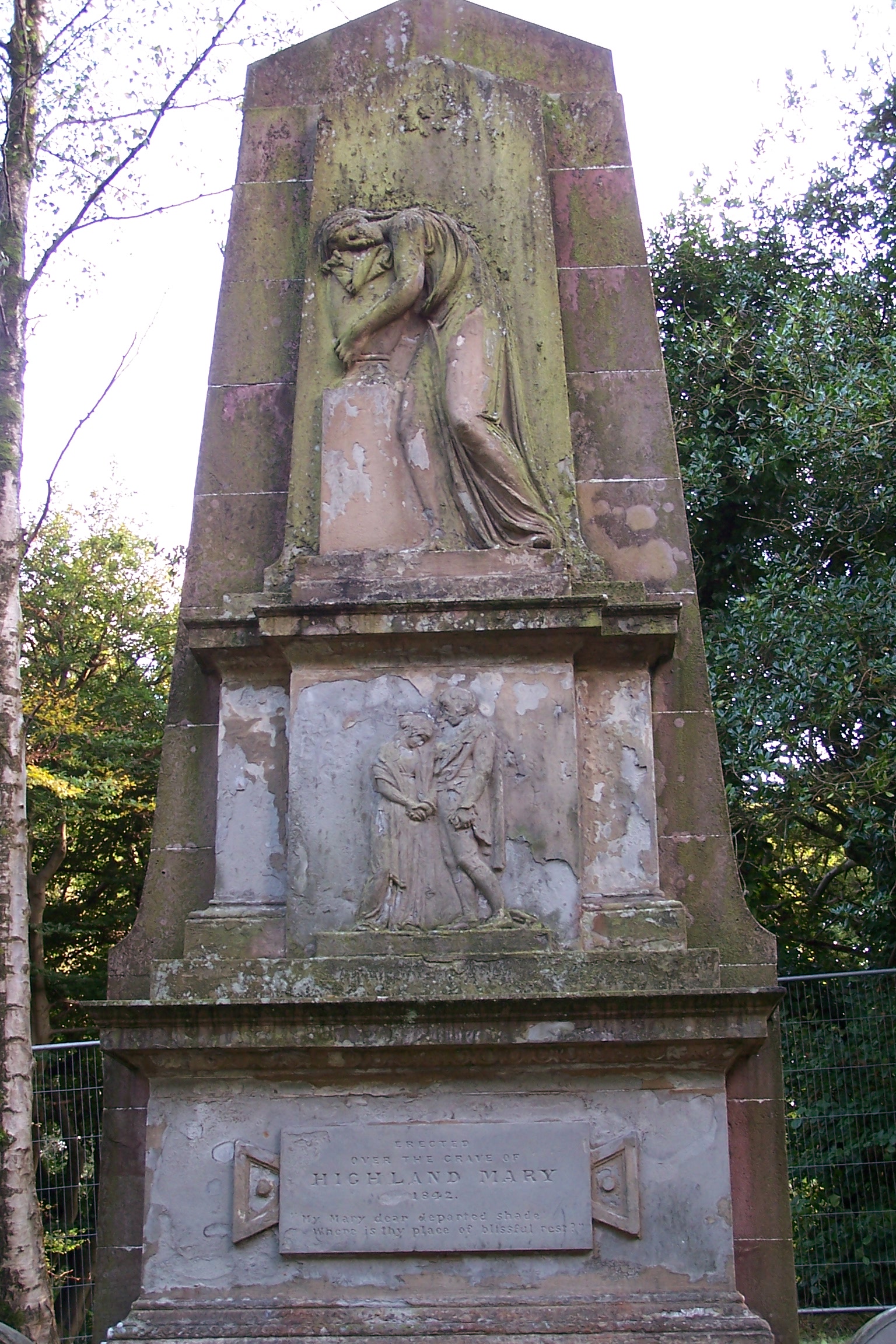|
Isabella Steven
Isabella Steven or Tibbie Stein was the daughter of a tenant farmer from Littlehill or Little Hill Farm (NS467305) that adjoined the Burns's farm at Lochlea.Boyle, Page 86 'Stein' is an alternative form of the surname 'Steven'. Littlehill had three acres of land that are said to have been little better than peat moss. She is also said to have lived in Tarbolton.'' Life and character Isabella or Tibbie was regarded as having been very good looking and at the age of seventeen Robert Burns was greatly attracted to her. The poet ''"deemed himself doing well in his courtship"'' until 'Tibbie' came into a legacy and dowry of £75 at which point she decided herself above a mere farmer's son. She married a more prosperous suitor soon after. Aged nine or ten at the time of these events, Isobel Burns, sister of the poet, is the only source of Isabella Stevens identification as being the 'Tibbie' of the song.MacKay, Page 80 A Tarbolton tradition holds that 'Tibbie' lived in the village on ... [...More Info...] [...Related Items...] OR: [Wikipedia] [Google] [Baidu] |
Tarbolton
Tarbolton ( sco, Tarbowton) is a village in South Ayrshire, Scotland. It is near Failford, Mauchline, Ayr, and Kilmarnock. The old Fail Monastery was nearby and Robert Burns connections are strong, including the Bachelors' Club museum. Meaning of place-name Tarbolton has been suggested as having one of three meanings: * Village by the tor or hill, from Old English ''torr'' 'tor, hill, cliff' and ''boðl-tun'' /''bothl-tun'' "village with buildings, equivalent to Bolton in Greater Manchester. The name was recorded as ''Torbolten'' in 1138, suggesting this origin. * Village by the field and hill, from Old English ''torr'' 'tor, hill, cliff' and ''bāll'' 'field (not meaning the same as ball 'ball', i.e. football), as in Dunball, Somerset, with ''tun'' 'farm, village'. The name's record in writing as ''Torballtone'' in 1209 suggests this origin ''may'' be possible. * Village by the hill, from Old Gaelic ''tor'', modern Gaelic ''tòrr'', (where the Old English word is derived fro ... [...More Info...] [...Related Items...] OR: [Wikipedia] [Google] [Baidu] |
Mary Campbell (Highland Mary)
Mary Campbell, also known as Highland MaryBurns Encyclopedia Retrieved : 17 March 2012 (christened Margaret, March 1763 Retrieved 23 March 2012 – 1786), was the daughter of Archibald Campbell of Daling, a sailor in a revenue cutter,Annandale, V.1, Page 173 whose wife was Agnes Campbell of Achnamore or Auchamore. Mary was the eldest of a family of four. had an affair with her after he felt that he had been "deserted" by |
History Of South Ayrshire
History (derived ) is the systematic study and the documentation of the human activity. The time period of event before the invention of writing systems is considered prehistory. "History" is an umbrella term comprising past events as well as the memory, discovery, collection, organization, presentation, and interpretation of these events. Historians seek knowledge of the past using historical sources such as written documents, oral accounts, art and material artifacts, and ecological markers. History is not complete and still has debatable mysteries. History is also an academic discipline which uses narrative to describe, examine, question, and analyze past events, and investigate their patterns of cause and effect. Historians often debate which narrative best explains an event, as well as the significance of different causes and effects. Historians also debate the nature of history as an end in itself, as well as its usefulness to give perspective on the problems of the p ... [...More Info...] [...Related Items...] OR: [Wikipedia] [Google] [Baidu] |
18th-century Scottish Women
The 18th century lasted from January 1, 1701 ( MDCCI) to December 31, 1800 ( MDCCC). During the 18th century, elements of Enlightenment thinking culminated in the American, French, and Haitian Revolutions. During the century, slave trading and human trafficking expanded across the shores of the Atlantic, while declining in Russia, China, and Korea. Revolutions began to challenge the legitimacy of monarchical and aristocratic power structures, including the structures and beliefs that supported slavery. The Industrial Revolution began during mid-century, leading to radical changes in human society and the environment. Western historians have occasionally defined the 18th century otherwise for the purposes of their work. For example, the "short" 18th century may be defined as 1715–1789, denoting the period of time between the death of Louis XIV of France and the start of the French Revolution, with an emphasis on directly interconnected events. To historians who expand ... [...More Info...] [...Related Items...] OR: [Wikipedia] [Google] [Baidu] |
Peggy Thompson
Margaret "Peggy" Thompson, later Margaret Neilson, was the housekeeper at Coilsfield House or Montgomery Castle in Ayrshire, Scotland. She married John Neilsen of Monyfee. The couple lived at Minnybae Farm near Kirkoswald. She was the 'charming Fillette' of Robert Burns fame and her husband was an old acquaintance of the poet. It was on 23 August 1775 that she was first seen in her garden by Burns when he was out at noon in the school's backyard measuring the altitude of the sun. Peggy in later life moved to Ayr where her children still lived in 1840. Association with Robert Burns As stated Burns first met her when he was studying at Kirkoswald school in the summer of 1775 under the schoolmaster Hugh Rodger (1726-1797). She lived with her parents, next door to the school, and Robert Burns recorded that she ''"over-set my trigonometry, and set me off in a Tangent from the sphere of my studies"''. Robert Burns met Peggy Thompson frequently at Tarboth or Tarbolton Mill and they ... [...More Info...] [...Related Items...] OR: [Wikipedia] [Google] [Baidu] |
Anne Rankine
Anne Rankine was the youngest daughter of a tenant farmer, John Rankine from Adamhill Farm that lay two miles from the Robert Burns's family farm at Lochlea. She married John Merry, an inn-keeper in Cumnock on 29 December 1782,Mackay, Page 72 and is buried in Cumnock old churchyard. She maintained she was the 'Annie' of Robert Burns' song 'The Rigs o' Barley', however some maintain that she was merely trying to encourage business at their inn at Cumnock. Her father was brother-in-law to John Lapraik the poet.Purdie, Page 19 Life and character As stated, Anne was the daughter of a tenant farmer, a friend of Robert Burns, who is described by him as ''"rough, rude, ready-witted Rankine"''. She married an inn-keeper, John Merry, who died in 1802 and thereafter she ran the inn herself until she died in 1843, aged 84.Boyle, Page 1 Burns lodged at the inn in August 1786, four years after the song was written. [...More Info...] [...Related Items...] OR: [Wikipedia] [Google] [Baidu] |
Jessie Lewars
Jessie Lewars also known as Mrs. James Thomson,Westwood, Page 1 was the youngest daughter of John Lewars, a supervisor of excise. Following the death of her 69-year-old father in 1789, Jessie was only 11 years old, when she and her brother John moved to a house in Millhole Brae (now Burns Street) that lay opposite that of Robert Burns in Dumfries. Jessie was a close Burns family friend and when nearly at the age of eighteen helped the family by nursing Robert in the days leading up to his death and doing the domestic chores.Mackay, page 624Westwood (2008), Page 96 Life and character Jessie had a brother and also an older sister, Mary, who married William Hyslop, a Dumfries builder. As teasingly predicted by Robert Burns, Jessie married James Thomson, a lawyer or solicitor, in Dumfries on 3 June 1799. The couple had five sons and two daughters. The sons were James (1800–1820); John (1802–1834), who worked with his father; William (1805–1858), who was a captain in the mercha ... [...More Info...] [...Related Items...] OR: [Wikipedia] [Google] [Baidu] |
Nelly Kilpatrick
Nelly or Nellie Kilpatrick, Helen Kilpatrick or later Nelly Bone (1759–1820). Nelly (usually short for "Helen") was possibly Robert Burns's first love and muse as stated by Isabella Burns. Early life Nelly is usually used as a nickname for "Helen." Some authors give her birth year as 1760. Nelly may have been the daughter of John Kilpatrick,Mackay, page 52 the miller and his wife Jane Reid of Perclewan Mill near Dalrymple.Burns Encyclopedia Retrieved : 2012-02-06 She was baptised on 1 March 1759. Life and character  He sta ...
He sta ...
[...More Info...] [...Related Items...] OR: [Wikipedia] [Google] [Baidu] |
Kate Kemp
Kate Kemp of Barskimming lived with her father at the Bridge House on the northern side of the single span Barskimming Old Bridge (Barskimming Auld Brig), River Ayr, Scotland. Both Robert Burns and James Andrew, the miller at Barskimming Mill, had a romantic interest in her and one visit led to the composition of the poem and dirge " ''Man was made to Mourn''". Life and character Her father may have been the James Kemp of Barskimming who is recorded in the Parish of Stair as the father of William Kemp who was baptised on 19 August 1766 being around eighteen in 1784 and any sibling a likely similar age. No other 'Kemp' births are recorded around this time, however in 1781 a Margaret Kemp from Mauchline came to live in the parish of Stewarton with a 'clearance certificate' of good character. Kate lived in a sylvan and delightfully rural location at the old Barskimming Bridge or Kemp's House (NS4906525460) that lay on the north or Mauchline side of the road to Stair about two mi ... [...More Info...] [...Related Items...] OR: [Wikipedia] [Google] [Baidu] |
Jenny Clow
Janet, Jennie or Jenny Clow was a domestic servant to Mrs Agnes Maclehose, née Craig (1759-1841), the Clarinda to Robert Burns' Sylvander.Burns Encyclopedia Retrieved : 2012-02-26 She was the daughter of Andrew (or AlexanderWestwood, Page 138) Clow and Margaret Inglis from and was the youngest of eight children.Rootsweb Retrieved : 2012-02-26 Her mistress sent her to deliver a letter to the poet and he seduced her. [...More Info...] [...Related Items...] OR: [Wikipedia] [Google] [Baidu] |
May Cameron
May Cameron also known as Margaret, Peggy, or Meg Cameron,Burns Encyclopedia Retrieved : 2012-03-11 was a servant in Edinburgh, working at a house close to that of William Creech, Burns's Edinburgh publisher. retrieved : 2012-03-11 Life and character May Cameron was, as stated, a servant girl working in Edinburgh. After a brief relationship with she lost her job and had at first to rely upon the poet for funds. May married her cousin Mungo Forbes in September 1788. Mackay states that she was a Highlander.[...More Info...] [...Related Items...] OR: [Wikipedia] [Google] [Baidu] |
Robert Burns
Robert Burns (25 January 175921 July 1796), also known familiarly as Rabbie Burns, was a Scottish poet and lyricist. He is widely regarded as the national poet of Scotland and is celebrated worldwide. He is the best known of the poets who have written in the Scots language, although much of his writing is in a "light Scots dialect" of English, accessible to an audience beyond Scotland. He also wrote in standard English, and in these writings his political or civil commentary is often at its bluntest. He is regarded as a pioneer of the Romantic movement, and after his death he became a great source of inspiration to the founders of both liberalism and socialism, and a cultural icon in Scotland and among the Scottish diaspora around the world. Celebration of his life and work became almost a national charismatic cult during the 19th and 20th centuries, and his influence has long been strong on Scottish literature. In 2009 he was chosen as the greatest Scot by the Scottish pub ... [...More Info...] [...Related Items...] OR: [Wikipedia] [Google] [Baidu] |


.jpg)


